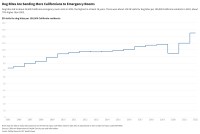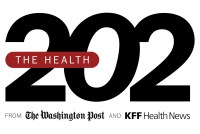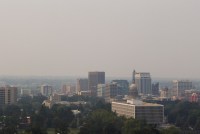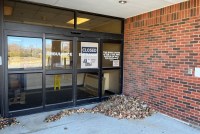Latest KFF Health News Stories
Where Are the Nation’s Primary Care Providers? It’s Not an Easy Answer
Politicians keep talking about fixing primary care shortages. But flawed national data leaves big holes in how to evaluate which policies are effective.
A Record Number of Californians Are Visiting Emergency Rooms for Dog Bites
There were nearly 50,000 emergency room visits for dog bites in California in 2022. The rate of such visits per capita is up about 70% since 2005.
Native American Communities Have the Highest Suicide Rates, Yet Interventions Are Scarce
Native Americans die by suicide at a higher rate than any other racial or ethnic group, yet research into effective and culturally appropriate interventions is uncommon.
Medicare Advantage Is Popular, but Some Beneficiaries Feel Buyer’s Remorse
Medicare Advantage plans are booming — 30.8 million of the 60 million Americans with Medicare are now enrolled in the private plans rather than the traditional government-run program. But a little-known fact: Once you’re in a Medicare Advantage plan, you may not be able to get out. Traditional Medicare usually requires beneficiaries to pay 20 […]
As climate change-driven wildfires increasingly choke large parts of the United States with smoke each summer, new research shows residents in long-term care facilities are being exposed to dangerously poor air, even those who don’t set foot outside during smoke events.
Rising Suicide Rate Among Hispanics Worries Community Leaders
The suicide rate for Hispanics in the United States has increased significantly over the past decade. The reasons are varied, say community leaders and mental health experts, citing factors such as language barriers, poverty, and a lack of bilingual mental health professionals.
In This Oklahoma Town, Most Everyone Knows Someone Who’s Been Sued by the Hospital
Hospitals nationwide face growing scrutiny over how they secure payment from patients, but at one community hospital, the debt collection machine has been quietly humming along for decades.
Federal Program to Save Rural Hospitals Feels ‘Growing Pains’
Fewer than two dozen rural hospitals were converted into Rural Emergency Hospitals in the program’s first year. Now, advocates and lawmakers say tweaks to the law are necessary to lure more takers and keep health care in rural communities.
Rural Hospitals Are Caught in an Aging-Infrastructure Conundrum
Small, community hospitals face challenges in paying for the capital improvement projects they need to stay open.
What Would a Nikki Haley Presidency Look Like for Health Care?
Former South Carolina Gov. Nikki Haley’s tenure in the Palmetto State — which overlapped with several tumultuous years of health care reform — and her recent comments offer clues to how her presidency might affect national health care policy.
Delays in State Contracts Leave Montana Health Providers Strapped
The Montana Department of Public Health and Human Services is months behind in paying organizations contracted to connect people to care. The interruption is likely to have lasting effects, even after the state catches up.
Rising Malpractice Premiums Price Small Clinics Out of Gender-Affirming Care for Minors
Even in states where laws protect minors’ access to gender-affirming care, malpractice insurance premiums are keeping small and independent clinics from treating patients.
Adultos mayores se sienten “atrapados” en planes de Medicare Advantage
Al parecer el programa de planes privados para adultos mayores comienza a presentar obstáculos cuando surgen enfermedades.
Older Americans Say They Feel Trapped in Medicare Advantage Plans
As enrollment in private Medicare Advantage plans grows, so do concerns about how well the insurance works, including from those who say they have become trapped in the private plans as their health declines.
Listen to ‘Tradeoffs’: How the Loss of a Rural Hospital Compounds the Collapse of Care
Six years ago, the hospital in Fort Scott, Kansas, shuttered, leaving residents in the small community without a cornerstone health care institution. In the years since, despite new programs meant to save small hospitals, dozens of other communities have watched theirs close.
Can Family Doctors Deliver Rural America From Its Maternal Health Crisis?
Family medicine doctors already deliver most of rural America’s babies, and efforts to train more in obstetrics care are seen as a way to cope with labor and delivery unit closures.
Child Care Gaps in Rural America Threaten to Undercut Small Communities
Deep gaps in rural America’s child care system threaten communities’ stability by shrinking the workforce and inhibiting economic potential. Now that pandemic-era federal aid for child care programs and low-income families has ended, it’s up to state and local leaders to find solutions.
The Year in Opioid Settlements: 5 Things You Need to Know
In the past year, opioid settlement money has gone from an emerging funding stream for which people had lofty but uncertain aspirations to a coveted pot of billions being invested in remediation efforts. Here are some important and evolving factors to watch going forward.
Inside the Pentagon’s Painfully Slow Effort to Clean Up Decades of PFAS Contamination
Cost estimates balloon and complications mount as the Defense Department grapples with PFAS pollution at hundreds of its bases and surrounding communities.
What a Bison Goring Can Teach Us About Rural Emergency Care
Millions of Americans live in “ambulance deserts” — areas that are more than a 25-minute drive to the nearest emergency medical services (EMS) station. The most rural areas can be more than an hour away from help. These sparsely populated communities can have trouble sustaining ambulance services, if small patient volumes and low reimbursements […]
























